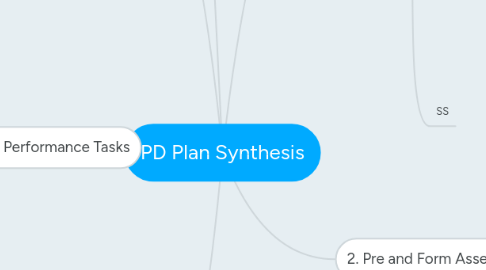
1. 4. Big Ideas of Assess.
1.1. Math
1.1.1. Working on formative assessment practices
1.1.2. Discussions around triangulation of evidence
1.1.3. Continuing work on small group instruction as assessment opportunity
1.1.4. Sharing of assessments and diagnostics from other Divisions, collaborating with other Divisions around assessment tools
1.1.5. Considerable work on involving students in assessment, co-constructing criteria, self and peer assessment, goal setting, in all subject areas
1.2. Digital
1.2.1. portfolios, digital options that allow for learning flow
1.3. Library
1.3.1. assessing learning in the inquiry context
1.4. Literacy
1.5. SS
2. 5. Designing Performance Tasks
2.1. Math
2.1.1. Currently reading (some chapters collaboratively) Brookhart "Assessing Higher Order Thinking Skills"
2.2. Digital
2.2.1. using capture technologies
2.3. Library
2.3.1. inquiry learning
2.3.2. resource support for differentiation
2.4. Literacy
2.5. SS
3. 6. Student Choice to Dem. Learning
3.1. Math
3.1.1. Work in all subject areas around flexible, student lead assessment
3.2. Digital
3.2.1. device selection
3.2.2. blended learning
3.3. Library
3.3.1. assist students to develop personal learning networks
3.3.2. assist students with resources and technology to demonstrate learning
3.4. Literacy
3.4.1. Independent Reading
3.5. SS
4. RTI
4.1. Exploration of math supports in other Divisions
4.2. Collection and distribution of various math supports that can be used to fill gaps and support struggling learners
4.3. Collection and sharing of diagnostic assessments
5. 1. UBD
5.1. Math
5.1.1. Creating UbD units in math
5.1.2. Providing UbD planning support on blog
5.1.3. Collecting and posting sample math UbD units
5.1.4. Continuing to tie UbD philosophy into conversations around instruction
5.2. Digital
5.2.1. expanding assessment options
5.2.2. differentiation and learning styles with mobile devices
5.3. Library
5.3.1. planning inquiry units with UbD
5.3.2. resource support for units
5.4. Literacy
5.4.1. planning with teachers (PALS and individual teacher requests)
5.4.2. January 30 PD Session
5.4.3. Creations of sample unit
5.4.4. Creating Support Documents
5.4.4.1. 1. self-assessment
5.4.4.2. 2. GSSD UbD Planning Guide
5.4.4.3. 3.
5.5. SS
6. 2. Pre and Form Assess.
6.1. Math
6.2. Digital
6.2.1. digital pre assessments , exit slips
6.3. Library
6.3.1. resource support for teachers designing assessments
6.4. Literacy
6.4.1. RAD (created flow chart)
6.4.1.1. instructional support documents
6.4.2. F&P (created flow chart)
6.4.2.1. co-assessing with new teachers
6.4.3. Running Records (created template)
6.5. SS
7. 3. Flexible Groupings
7.1. Math
7.1.1. Support and resources for math PODS
7.1.2. Sharing leadership around small group instruction in math between teachers and schools and also with other Divisions
7.2. Digital
7.2.1. incorporating devices (mobile and other)
7.3. Library
7.4. Literacy
7.4.1. Grade 3 Initiative
7.4.1.1. 1. Guided Reading
7.4.1.1.1. 2. Independent Reading
7.4.2. Grade 1 Pilot
7.4.2.1. Word Study
